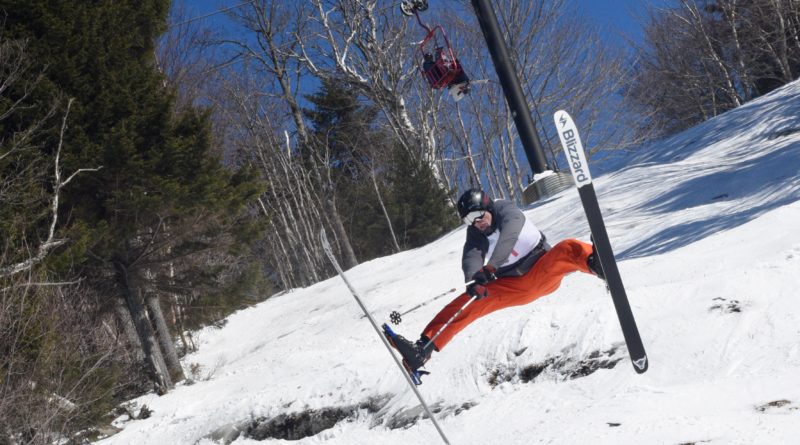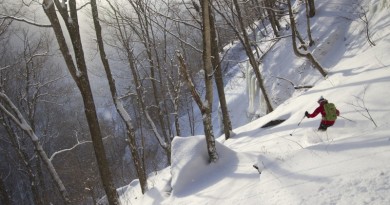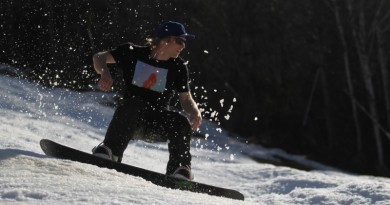And Magic’s “Best Skier in the East” Is..A Walk On
On a sunny day in mid-March, Rich Hart — a 44-year-old from Connecticut — stood at the base of Magic Mountain wearing a skin-tight, green speed suit and holding a beer. It was just noon and it was not his first.
“I’m pumped for this, but it’s going to be solid,” he said, looking up at Londonderry’s Magic Mountain where a thin layer of fresh snow covered a base that had hardened up with this past winter’s freeze/thaw cycles. “Now this is the guy I’ll need to beat,” he said, nodding to a skier next to him. Zach Wilkens, a 24-year-old who lives in Killington. Wilkens was in a baggy Fly Low parka and pants. “That’s why the speed suit —I won’t be flapping around as much as Zach here,” Hart ribbed his friend.

The “race,” the Master of the Mountain Extreme Biathlon, was set to go off at 1 pm, to “crown the best overall skier or rider in the East.” A combination of freeskiing comp and race through the gates, it sends competitors from near the top of the mountain, where they are judged on their air, line, fluidity and speed, on down Blackline trail where a series of gates are set up. Overall time, top to bottom, is part of what makes a winner, but also jump, fluidity and control are judged as well. At stake: a $1500 prize purse.
Wilkens, the defending champion, had already won one of Magic’s trio of extreme events this year. On Feb. 2, he captured first place in The Road to Ruin, basically, a Chinese downhill where heats of racers take off in a no-gates downhill mad dash from the top of the intersection of Redline and Witch to the bottom. The winner advances to the next round. Wilkens had won that and a check for $1000.
Both had also competed in Tuck It! on December 31, 2018— a straight-out, no-gates speed challenge. “We both clocked 70- to 71- mph,” Hart said. “But we didn’t win.”
The three events form a trio that defines Magic’s quest to bring the “soul” back into skiing. “We’re just trying to have fun,” said Geoff Hatheway, the general manager and one of the investors who has helped bring Magic back over the last few years following an era of financial instability.
On the side of the same slope where the Master of the Mountain Extreme Biathlon would come down, a tubing park had kids sliding down shrieking with laughter. A guy on a Sno Go ski bike, a bike with a forward ski and two back skis, carved down the mountain and skidded to a stop near the Red Chair lift, music blaring from a speaker mounted on the handlebars. “A lot of places wouldn’t let me use this on the slopes,” said the rider, Robert Dunn, who comes up weekends from New Jersey. “I just asked Geoff about it and he said ‘Sure, if you can handle this.’ Geoff’s done an awesome job with this place.”
 Magic is not your grandfather’s ski hill. Yet, it has a retro back-to-the-future feel. The influence of its founder, Swiss ski instructor Hans Thorner – who arrived from the Alps and founded Magic in 1960 —is everywhere. Swiss-style chalets such as Blue Gentian and Snowden Chalet still offer lodging near the base. There’s little development and even some of the newer buildings give a nod to Alpine architecture. The lift tickets are cheap (as low as $29), the music at the Black Line Tavern is good and there’s a vibe here that’s hard to match.
Magic is not your grandfather’s ski hill. Yet, it has a retro back-to-the-future feel. The influence of its founder, Swiss ski instructor Hans Thorner – who arrived from the Alps and founded Magic in 1960 —is everywhere. Swiss-style chalets such as Blue Gentian and Snowden Chalet still offer lodging near the base. There’s little development and even some of the newer buildings give a nod to Alpine architecture. The lift tickets are cheap (as low as $29), the music at the Black Line Tavern is good and there’s a vibe here that’s hard to match.
Alongside the extreme skiers are families who have come here for generations. The line-up for a sunny Saturday in March with good snow is blissfully short. In fact, says Hatheway, he stops selling lift tickets if the mountain starts to get crowded. The iconic red chair rises up the steep, 1500-feet of vertical, over glades and steeps that give this mountain the reputation of the Mad River Glen of southern Vermont.
And that’s what draws some of the best skiers in the East here — as both season pass holders and the weekenders who are here for the Master of the Mountain Extreme.
At the top of the course, a crowd of two dozen racers has gathered. One by one, they head down. It’s icy. There are exposed rocks. The moguls are hard as granite. Some skiers like Clark Macomber float through, conservative, in control and launching air when they can. Others, like Hatheway’s brother Jeff, blaze down, borderline in control, but going as fast as they can.
Then it comes time for Wilkens, the defending champ, to compete. He skis the top part well, hits a bump and throws huge air, spreads his skis wide, poles and fists down. He sails up, and up, until there’s at least 14 feet between him and the ground below and then lands and sticks it.
There’s another jump Wilkens has eyed down the slope and he hits that one too – and blows up. It’s a yard sale that has him hunting and pecking for gear. Not far behind, Hart replicates Wilkens run with an air that’s nearly as big. He lands with a flat thud and a grunt that’s so loud it cracks up the judges who are watching, trailside. He too goes for another air and bails. No guts, no glory.
In the end, the big prize goes to Clark Macomber, a 22-year-old senior at St Lawrence University. Macomber, a slalom and GS ski racer with FIS points seems as comfortable in the air as he did in the gates (see John Hatheway’s video of his run below) It’s a one-run event and there’s no second chance — until next year.
“I didn’t even know the race was going on,” says Macomber after the race. “I came down to ski for the weekend with my buddy Stod Rowley who lives in the area and just decided to enter last minute. I’m not really great as a freeskier but I know how to go fast. I loved the terrain.”
The race is done but that doesn’t mean the fun doesn’t stop. In Hatheway’s eyes, the season is far from over and on March 23, anyone can enter the Shovel Race, which is, you guessed it, a chance to ride a shovel down the slopes.
For more information see magicmtn.com
Photos by Angelo Lynn. Featured photo is of Zach Wilkens
Clark Macomber (in gray jacket) on his winning run:




